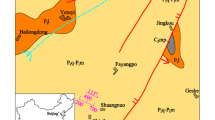Abstract
To identify problematic geological structures which would be encountered when driving tunnels in the high mountainous area of South West China, a joint geophysical and engineering geological study was made. The tunnels will form part of a project to divert water from the Yangtze to the Yellow Rivers. A controlled source audio-frequency magnetotelluric method (CSAMT) was carried out in 2004 between the Ma-ke and Jia-qu rivers in high, steep terrain. The paper discusses the method of data collection, processing, and analysis for the West route. The faults/fractures identified will need to be taken into account in the design and construction of the tunnel.
Résumé
Afin d’identifier des structures géologiques contraignantes qui pourraient être rencontrées lors du creusement de tunnels au travers des régions montagneuses de la Chine du sud-ouest, une étude couplée de géophysique et de géologie de l’ingénieur a été réalisée. Les tunnels feront partie du projet de détournement des eaux du bassin du Yangtze vers celui du Fleuve Jaune. Une méthode magnéto-tellurique (CSAMT) a été mise en œuvre en 2004 entre les rivières de Ma-ke et Jia-qu dans une région d’altitude présentant des pentes raides. L’article discute des méthodes de récupération, traitement et analyse des données pour l’itinéraire de l’Ouest. Les failles et fractures identifiées devront être prises en compte dans la conception et la construction du tunnel.









Similar content being viewed by others
References
Basokur AT, Rasmussen TM, Kaya C (1997) Comparison of induced-polarisation and controlled-source audio-magnctotellurics methods for massive chalcopyrite exploration in a volcanic area. Geophysics 62(6):1087–1096
Batrel LC, Jacobson RD (1987) Results of a controlled-source audiofrequency magnetotelluric survey at the Puhimau thermal area, Kilauea Volcano, Hawaii. Geophysics 52(4):665–677
Boerner DE, Wright JA, Thurlow JG (1993) Tensor CSAMT studies at the Buchans Mine in central Newfoundland. Geophysics 58(1):12–19
Bostick FX (1986) Electromagnetic array profiling (EMAP).In: Proceedings of (56th) SEM Annual Meeting Expanded Technical program, Abstract with biographies, pp 60–61
David EB, Ron DK, Alan GJ (1993) Orthogonality in CSAMT and MT measurements. Geophysics 58(7):924–934
Di QY, Wang MY, Shi KF, Zhang GL (2002a) CSAMT research survey for preventing water-bursting disaster in mining. In: Proceedings of the 106th SEGJ Conference, The Society of Exploration Geophysicists of Japan, Tokyo, pp 43–49
Di QY, Wang MY, Shi KF, Zhang GL (2002b) An applied study on prevention of water bursting disaster in mines with the high resolution V6 system. Chinese J Geophys 45(5):744–748 (in Chinese)
Goldstein MA (1971) Magnetotelluric experiments employing an artificial dipole source (D), University of Toronto
Goldstein MA, Strangway DW (1975) Audio frequency magnetotelluric with a grounded dipole source. Geophysics 40(4):669–683
Jimmy S, Gokarn SG, Manoj C, Singh SB (2003) Effects of galvanic distortions on magnetotelluric data: Interpretation and its correction using deep electrical data. Earth Planet Sci 112(1):27–36
Jiracek GR (1990) Near surface and topographic distortions in topographic induction. Surv Geophys 11(1):163–203
Lu X, Unsworth M, Booker J (1999) Rapid relaxation inversion of CSAMT data. Geophys J Int 138(1):381–392
Macinner SC (1987) Lateral effects in controlled source audiomagnetotellurics. Ph. D. thesis, University of Arizona, Tucson
Routh PS, Oldenburg, DW (1996) Inversion of controlled-source audio-frequency magnetotelluric data for a horizontally layered earth. In: Proceedings 66th Annual International Meeting, The Soceity of Exploration Geophysicsts, Expanded Abstracts, pp 257–260
Sandberg SK, Hohmann GW (1982) Controlled-source audio-magnetotellurics in geothermal exploration. Geophysics 47(1):100–116
Sasaki Y, Yoshihiro Y, Matsuo K (1992) Resistivity imaging of controlled-source audio frequency magnetotelluric data. Geophysics 57(3):952–955
Takeshhi K (1953) The topographic effect in resistivity prospecting. Geophys Explor (Butsuri-Tansa) 6(1):51–54
Wannamaker PE (1997) Tensor CSAMT survey over the sulphur springs thermal area, Valles Caldera, New Mexico, USA, Part I: implications for structure of the western equations. Geophysics 62(4):451–465
Wu LP, Shi KF (1996) Applied study of CSAMT method on ground water exploration. Chinese J Geophys 39(5):712–717 (in Chinese)
Xu SZ, Zhao SK (1985) Tomographic effect in MT exploration. Seismol J Northwest 7(4):422–427 (in Chinese)
Yamashita M, Hallof PG, Pelton WH (1985) CSAMT case histories with a multi-channel CSAMT system and discussion of near-field data correction. In: Proceedings 55th SEG Annual Convention, Calgary, Canada: [s. n.], pp 276–278
Zonge KL, Hughes LJ (1991) Controlled source audio-frequency magnetotellurics. In: Nabighian MN (ed) Electromagnetic methods in applied geophysics. Soc Expl Geophys Tulsa 2(B):713–809
Zonge KL, Ostrander AG, Emer DF (1986) Controlled-source audio-frequency magnetotelluric measurements, In: Vozoff K (ed) Magnetotelluric methods: Society of Exploration Geophysicsts, Tulsa, USA, Geophysics (Series 5) pp 749–763
Acknowledgments
The authors thank the financial support for this work from the project 2002CB412702 and KZCX3-SW-134.
Author information
Authors and Affiliations
Corresponding author
Rights and permissions
About this article
Cite this article
An, Z., Di, Q., Wu, F. et al. Geophysical exploration for a long deep tunnel to divert water from the Yangtze to the Yellow River, China. Bull Eng Geol Environ 71, 195–200 (2012). https://doi.org/10.1007/s10064-011-0358-7
Received:
Accepted:
Published:
Issue Date:
DOI: https://doi.org/10.1007/s10064-011-0358-7



